#Supersonic Passenger Airliner
Text

A former TWA Boeing 2707 SST in the boneyard.
Note: happy April fool's day
Date: April 1, 1998
source
#Boeing 2707-300#Boeing 2707#2707-300#2707#Supersonic Transport#SST#Supersonic Transport Project#National Supersonic Transport Program#NST#Supersonic Passenger Airliner#Cancelled#boneyard#TWA#1998#april fool's day#april fool's#April#my post
42 notes
·
View notes
Text

In the gate at JFK Int'l - Nov 25 2003
#Aérospatiale#Concorde#SST#Supersonic airliner#Passenger jet#Commercial aircraft#airliner#Air France#airport#JFK#aircraft#airplane#travel
78 notes
·
View notes
Text

A conceptual rendering of a supersonic transport flying over the then new Dallas Fort Worth International Airport.
#vintage illustration#vintage aircraft#aircraft#commercial aircraft#civilian aircraft#airplanes#vintage airplanes#passenger planes#airlines#airliners#jet airliners#sst#commercial jets#supersonic transport#dfw airport#dallas fort worth international airport
9 notes
·
View notes
Photo
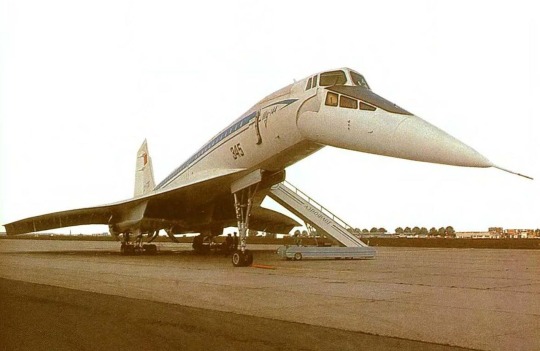
Tupolev Tu-144
#Tupelov#Tu-144#airliner#supersonic aircraft#civil aircraft#civil aviation#Russian aircraft#Soviet aircraft#passenger aircrafdt#commercial aircraft#airlines#Aeroflot
26 notes
·
View notes
Text
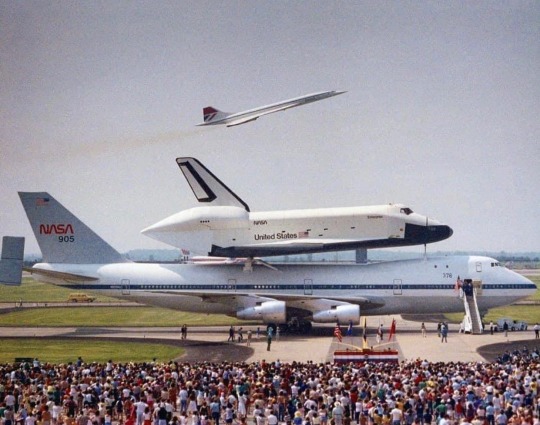
The pinnacle of civil aviation, when it seemed not even the sky was the limit, in a single picture: An Air France Concorde, the world’s first and only successful supersonic passenger aircraft, takes off while the Space Shuttle Enterprise, the first reusable space craft, sits atop a Boeing 747, the world’s first wide body airliner and for years the largest passenger aircraft in the world.
475 notes
·
View notes
Text
Miss Conenginality No. 5 - Tupolev Tu-134
So most planes I've talked about so far on this blog have been modern Boeing, Airbus, Embraer, Bombardier, and ATR models. These are now ubiquitous basically everywhere. Occasionally I'll bring up an old Douglas or even a Lockheed airliner. But back during the cold war Soviet airplanes were a thing, and by modern standards they're really different from what we're used to.
As someone of Soviet extraction I have a weird amount of pseudo-nostalgic fondness for these planes, many of which were out of service before I was born. So let's take a look at one I've looked at a lot in preparation for an upcoming post - the Tupolev Tu-134.

I would not say the Tu-134 is my number one favorite of the assorted weird-looking Soviet planes out there, but I would definitely say that I enjoy it a lot and I think beyond that it's a good starting point for weird-looking Soviet planes. It was common, with the better part of a thousand produced, and you could consider it the rough counterpart to something like a BAC One-Eleven or an earlier DC-9 - a nice and reliable plane to carry a relatively small number of passengers a short-to-medium distance, with a t-tail, two rear-mounted engines, and swept wings. It's just...a lot spikier.
The Tu-134 was introduced in 1970. It was built because Nikita Khrushchev took one flight in a Sud Aviation Caravelle and was so impressed by the quiet cabins of rear-engined planes that he demanded one be designed immediately. (This becomes funny when one realizes that by modern standards the Tu-134, as is true of most planes of its era, is so loud it's banned from many airfields.) Like the other handful of planes that Soviet leaders decided needed to be designed because they saw a Western plane and went "hey, I want something like that", the Tu-134 was designed by Tupolev, who had also designed the Soviet Union's first jet airliner (the Tu-104) and the Tu-144 supersonic airliner. I find that even by the standards of Soviet planes Tupolev models, while they might not be the weirdest-looking, might be the weirdest-functioning in their own little ways.

A lot of Soviet planes have at least a handful of design features that are pretty off-kilter. To begin with, a lot of these planes are designed to work on unpaved airstrips, presumably because Siberia. This is extra true of a model like the Tu-134, which has engines located higher off the ground, reducing the necessary clearance from rough terrain and the chance of foreign object damage while on the ground.
The Tu-134 is a different sort of beast, though. It's the equivalent of a Soviet DC-9 or BAC 1-11, with the rear engines and t-tail, but it looks like it's trying to hunch in on itself due to its wing sweep being a spectacular 35 degrees. That's around ten degrees more swept than comparable designs. Why? Tupolev.
(Presumably the increased efficiency in high subsonic flight regimes was considered worth the risk of uncommanded pitch-ups, which feels in keeping with Soviet design principles of the time, which favored designs which were high-performance but very unforgiving. Maybe the tail and engines were heavier than on comparable models and thus required the higher sweep. Just my guess, though, and I know very little.)
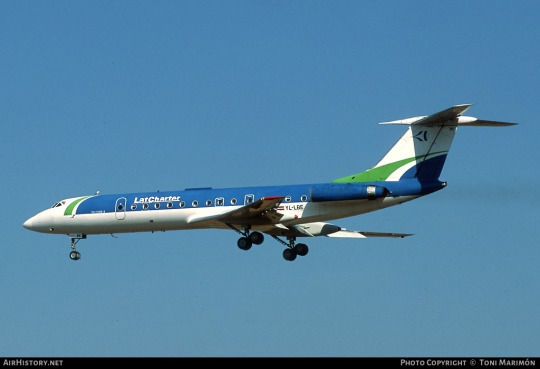
I just love the spikiness of this plane. The sweep on the wings means that no matter what angle you see it at it looks a bit silly, and the forward spike on the tailplane is just awesome. This entire plane looks like an arrow, or like a paper airplane model that nobody bothered to make less pointy when they scaled it up. Even the tapering of the fuselage up near the tail feels needlessly aggressive. It feels like an airliner dressed up as a fighter jet, or potentially a missile.

This is a plane which looks like if it struck another, much larger plane in midair it would simply go through it like a needle. This plane looks like you should be able to shoot it out of a very large bow. The wings are slightly anhedral (another reason for the excessive sweep may be to balance this out, as anhedral wings, or wings which slope downwards, sacrifice inherent roll stability for controllability, but this stabilizing effect is also conferred by swept wings. Yes, that is an oversimplification, but this post is about the visuals of the plane.) This always kind of makes the Tu-134 look like it's midway through flapping its wings, or like it's starting the process of folding up its wings via a hinge in the fuselage. It's almost a bit uncanny to be able to see the underside of the wing from angles that you normally definitely wouldn't. Anhedral wings are also a common feature of Soviet aircraft, but most of those are high-wing. It's sort of rare to see a low-wing anhedral aircraft in general aside from fighter jets. Those use computers to reduce the inherent instability of the configuration, but the Tu-134 was analogue. Very, very analogue. It actually ran on direct current. Why? Tupolev.
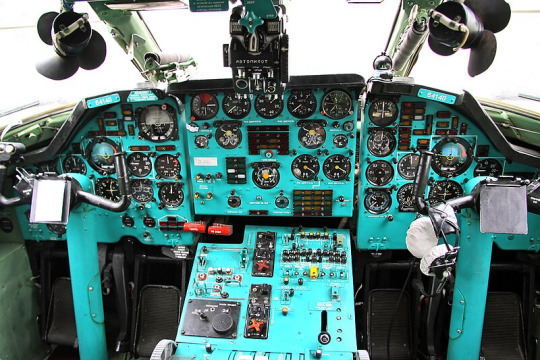
image: Vitaly Kuzmin
One thing I really like about Tupolev planes is that their cockpits were painted a delightful teal. This is not a unique Tupolev feature by any means (actually, the DC-9 had it) but they're the most consistent about it of any manufacturer I'm aware of. This apparently was meant to calm down pilots, presumably coming in useful during the uncommanded pitch-ups. (Extra nasty on a plane hypothetically able to deep-stall, though I can't find any record of a Tu-134 ever deep-stalling and its safety record was actually pretty good for its era.)

I have no idea what's up with that spike on the tail. The 707's tail spike was an antenna for high-frequency radio, so this might be something similar, but I'm not sure. (Check out the sweep on those horizontal stabilizers, though!)
Edit: the tail spikey is an anti-shock body, it seems!

There are two main models of Tu-134. How do you tell a Tu-134A from a Tu-134B? If you're a pilot, you'll probably be clued in by the lack of an APU (...the ICAO apparently thought this was fine, which worries me) but that's a bit hard to notice for a passenger. Thankfully, it should be easy to tell on landing, because the Tu-134A didn't have engines capable of producing reverse thrust. This is very uncommon (for good reason) but not unheard of. Does it solve the issue like the BAe 146, with an air brake and giant spoilers? Absolutely not, this is Tupolev.
DROGUE PARACHUTE.

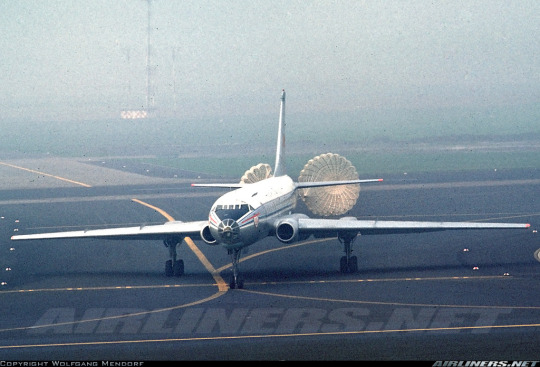
These are both the earlier Tu-104. I couldn't find any pictures of the Tu-134 using its parachute. Shame they didn't seem to bother adding liveries to them. Also, they're reusable, don't worry. And by 'they' I mean the parachutes, though the planes usually also are.
This does, surprisingly, have some actual advantages, in both high-speed emergency landings and in situations where the wheels can't find adequate purchase, like excessively gravelly or rainy runways. The earlier-mentioned BAe 146 was intended for operation on similarly rugged or short runways and, while it was generally safe, the margin for error was significantly reduced, with multiple fatal crashes related to overrunning runways in poor weather. Still, if I were the pilot of a plane which used one of these I would be perpetually terrified about the possibility of someone else running over my parachute. That would be potentially dangerous, not to mention incredibly awkward.
(That sounds like something you'd say to condescendingly ask a Tu-134 pilot why they're in a bad mood. Aww, someone run over your chute today?)
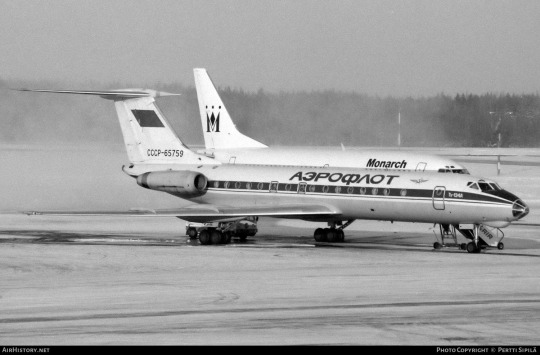
It's almost a bit bizarre seeing a Tu-134 next to a regular Western plane.
The main way to tell them apart at a glance, though, is the nose.

That little chin they've given her is where the radar is stored. Other airlines tend to keep this in the nose, but the Tu-134A used the nose for a much more important purpose. That's right, it's the
SOVIET NAVIGATOR PIT.

Soviet designs tended to use more flight crew for longer than Western ones, with planes retaining a dedicated radio operator and navigator in many cases. While this is a mostly innocuous design feature (you get severely diminishing returns for every flight crew member past the second, and risk breakdowns of communication by adding potential points of failure, but you do still have more brains on board to distribute tasks to) it has the pretty awesome result of the
SOVIET NAVIGATOR PIT.
This is to an extent a vestigial feature from the Tu-134's origin as the Tu-16 bomber (by way of the earlier Tu-124 and Tu-104 jet airliners, the latter of which was the second ever to fly). Still, this feature in Soviet planes isn't limited to Tu-16 derivations or even bombers, and can be found in planes like the Il-76.
Just think about flying on one of these. I get that it would be a nightmare for a lot of people, and I'll admit I don't love looking down at clouds from conventional cruise altitude myself, but I would love nothing more than to sit by one of these for a nice overland flight at a scenically suitable altitude (even though the glass seems like it might get cold).
Unfortunately, my hopes are not only dead but stillborn, as the Tu-134A is fully out of service. My hopes of flying on a Tu-134B are nearly as dire, but it's technically - very technically - possible. There remains one single operator of the Tu-134.

Air Koryo, the flag carrier of North Korea, still has two Tu-134 in its fleet. This poses a major problem, because currently my only passport is a US one, and US passports can't be used to enter North Korea. This ban is on the US's end rather than North Korea's, so if I could get a second passport from literally anywhere other than South Korea this would cease to be an obstacle, but even though I'm hypothetically eligible for a Russian passport there has never been a time I've wanted to get one less. You know, just in case I want to go to Poland or Latvia sometime. That is all to say...it's a race between Air Koryo retiring their Tu-134s, and me successfully getting another passport (and being able to afford a trip to North Korea on top of it). So unless any Irish citizens are eager to spend at least one year in a greencard marriage that dream is also quite dead. Sorry, sweet girl. It just wasn't meant to be.

Get a good look at those little raised bits on the wing, by the way. That's the old Soviet trick for keeping highly swept wings from doing that awful 'just kind of pitching up and losing control when close to stalling' thing, wing fences!
I just can't help but love this strange little pointy critter. Nobody ever designs planes that look quite this weird anymore, and I get that that's because the shape of an airliner has been more or less engineered to perfection by now, but it's still sort of a shame. This really was purely a Soviet thing - modern Russian designs like the Sukhoi Superjet and the Irkut MC-21 sort of just look broadly like 737s. The era of weird airliners seems to be largely over.
But at least when I review liveries, sometimes I'm able to gaze back through the rolled-up newspaper tube of history and see what planes looked like in a more imperfect time, when thrust reversers were an optional design choice and sometimes a plane was just very very pointy, because Tupolev.
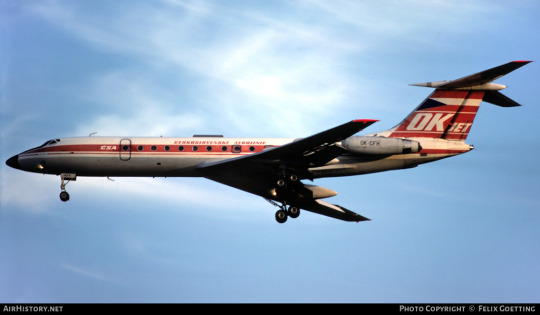

90 notes
·
View notes
Text
Which Thunderbirds Are Go episode is better?

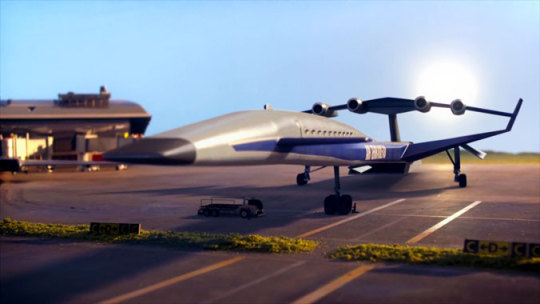
Vote on which episode you think is better. Episode synopses below the cut.
Break Out: Brains believes he can build a T-Drive engine for the Zero-XL, but he’ll need help from the Mechanic to do it. There’s just one small problem: the Mechanic is locked inside a high security space prison known as The Hex.
Fireflash: Kayo is riding aboard Fireflash, a supersonic airliner that was recently improved by Brains, unaware that the Hood is planning to hijack it in mid-flight. While International Rescue notices the plane has suddenly vanished from their monitors and attempt to locate it, Kayo manages to avoid a powerful gas attack that has knocked out both the passengers and the crew, and is forced to not only confront the Hood, but also safely land the airliner when the craft is accidentally damaged and the landing gear fails to deploy.
#thunderbirds are go#thunderbirds#thunderfam#tumblr polls#polls showdown#tournament poll#tumblr showdown
27 notes
·
View notes
Note
Can you tell me about the goofiest or coolest plane you know? :) /nf
yes! i’ll tell you about the concorde because i think it looks so goofy 💀

^ here’s a pretty picture i drew 😭
but here’s what it actually looks like:

the concorde (in production between 1965–1979) is a retired supersonic airliner, built for speed and optimal flight & made for 92-128 passengers, though 6 were made for non commercial purposes ( a total of 20 planes were made).
it has a droop nose which i find funny for some reason, made so they would have better visibility for landings. here’s a picture with the nose down!

and here’s a youtube video of the nose drooping!
youtube
i just think the plane looks a bit goofy in general compared to other airplanes. it’s just so shaped™️ i mean. triangle. vvv

———
[Air France Flight 4590]
on 25 July 2000 a concorde crashed shortly after takeoff, and sadly it killed all on board + a few on the ground. it was the only fatal incident with a concorde. their commercial services were suspended until november 2001, and they were retired in 2003.
———
as you can see its a pretty small plane, meaning that they could only have a four seated row inside the plane, with not super much head space.

———
the concorde has a wingspan of 25.6m, which is pretty small compared to the scaled composites model 351 stratolaunch, which has a wingspan of 117m! here’s a picture of that one!

———
so the concorde is a supersonic jet right? it’s maximum speed is 1,354 mph (2,179 km/h), which compared to my favourite plane aka the boeing 747 is pretty fast, the boeing 747s maximum speed is 659.85 mph (1,054 km/h). nyoooom. 💨
———
so yeah here’s a little information on the concorde! i hope you find it as much fun as i do hehe :3c
4 notes
·
View notes
Photo

In the early 1970s at the time of the launch of the British Aerospace BAe-146 (back then still Hawker Siddeley), there was considerable interest in STOL airliners in the industry. This particular design proposal was the Boeing/Aeritalia 751, a joint venture with the Italian aircraft company Aeritalia which at the time of this STOL airliner proposal, had just been formed with the merger of Fiat Aviazone and Aerfer. Aerfer built Italy's first supersonic jet, the Saggitario. Aeritalia merged with Aermacchi in 1990 to create Alenia Aeronautica. Work on the 751 began in 1970 with 40 Aeritalia engineers assigned to Boeing Renton. Unlike the BAe-146 though, it was a larger aircraft, seating 100-150 passengers. It would have had the capability of carrying 100 passengers 500 miles using runways under 2000 feet long. The design would have used the jet augmenter wing concept, which takes the concept of blown flaps further by arranging the exit slots in a way that boosts the airflow over the wing by pulling in ambient air and augmenting the airflow over the flaps. NASA tested a jet augmenter wing STOL on a converted DHC-6 Buffalo. However, the Arab Oil embargo in 1973 and subsequent rise in fuel prices led the 751 being quietly shelved. One of the drawbacks of jet augmenter designs is the added weight of the systems needed to allow STOL performance of the wing. The short range of the 751 also lessened its commercial appeal. It wasn't all for naught, though. Working with Aeritalia proved beneficial and in 1974, Boeing and Aeritalia signed a risk-sharing agreement to work on a new widebody twin that eventually became the Boeing 767. It was a new approach for Boeing, from the start of the design process, the 767 had to have better operating costs than any other previous design. #avgeek #aviation #aircraft #planeporn #instaplane #BAESystems #BritishAerospace #BAe146 #Boeing #Aeritalia #instagramaviation #splendid_transport #instaaviation #aviationlovers #flight #AvgeekSchoolofKnowledge #AvGeekNation https://www.instagram.com/p/CfB_rsVL-0S/?igshid=NGJjMDIxMWI=
#avgeek#aviation#aircraft#planeporn#instaplane#baesystems#britishaerospace#bae146#boeing#aeritalia#instagramaviation#splendid_transport#instaaviation#aviationlovers#flight#avgeekschoolofknowledge#avgeeknation
7 notes
·
View notes
Text

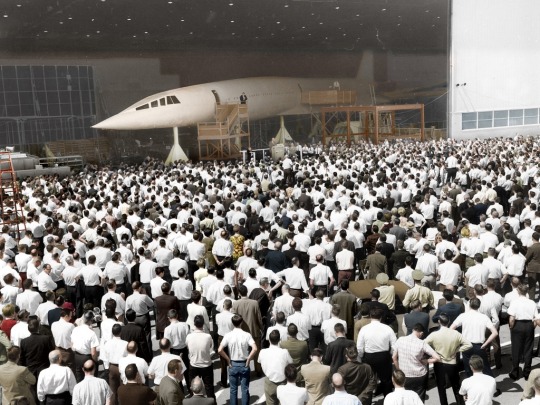
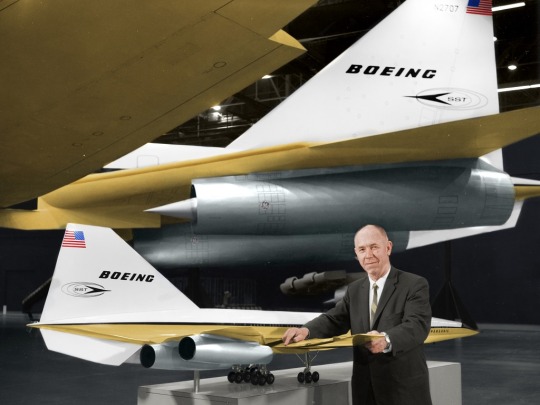

The Boeing 2707 was an American supersonic passenger airliner project during the 1960s. It was designed to carry 250 to 300 passengers with cruise speeds of approximately Mach 3. Rising costs and the lack of a clear market led to its cancellation in 1971 before two prototypes had been completed.
3 notes
·
View notes
Text
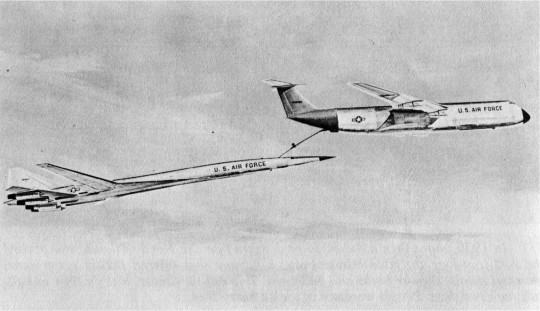
"The SST: Here it comes, ready or not.
Traditionally new transport aircraft have been adapted from military versions for civilian use. But with the US/SST, a switch may give the USAF an Advanced Manned Strategic Aircraft (AMSA) based on a civilian expenditure of billions in research and development funds. Here, Air Force & Space Digest artist Gordon Phillips shows how military SST would look during midair re-fueling operation.
by Don Dwiggins, Doubleday & Company, Inc., 1968"
Artwork by Gordon Phillips
Posted on Flickr by Numbers Station: link
#Boeing 2707-100#Boeing 2707#2707-100#2707#Supersonic Transport#SST#Supersonic Passenger Airliner#Cancelled#Lockheed C-5 Galaxy#C-5#Cargo Plane#United States Air Force#U.S. Air Force#US Air Force#USAF#inflight refueling#1960s#my post
26 notes
·
View notes
Text
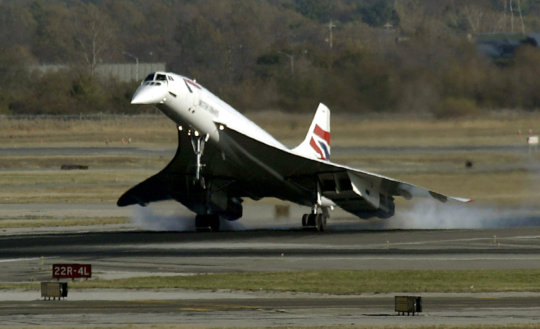
Concorde at East Hampton Airport, NY
177 notes
·
View notes
Photo
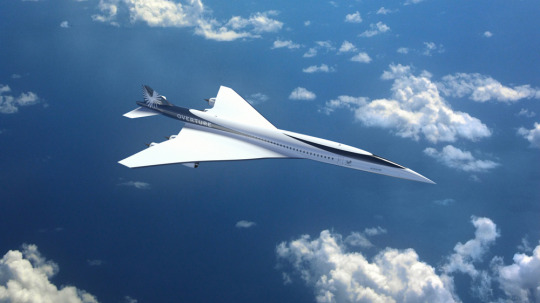
American Airlines orders 20 Boom Supersonic passenger jets
---
5 notes
·
View notes
Text

From Business Insider Deutschland
At the Farnborough Airshow, Boom Supersonic presented a revised version of its supersonic aircraft. Instead of 55 passengers, the aircraft will now be able to carry 65 to 80 passengers, and instead of two engines, Boom Supersonic plans to equip the aircraft with four engines. For the launch customer United Airlines, however, nothing will change for the time being.
The U.S. airline has ordered 15 Boom Overture passenger aircraft from U.S. start-up Boom Supersonic. The first flights are planned for 2026, and the first passengers could not board until 2029. Flight times could change drastically: The planes are expected to make the New-York London route in 3:30 hours instead of 6:30 hours now. Tokyo-Seattle could shorten from 8:30 hours to 4:30 hours, and Los Angeles-Sydney could be done in 8 hours instead of 14:30.
The purchase price per jet is $200 million (about 165 million euros). There are no further financial details on the agreement. However, it includes a purchase option for 35 additional aircraft. Supersonic aircraft have disappeared from civil aviation since the early 2000s with the end of the Concorde. The name recalls an era when it was possible to fly from London to New York in just three hours.
2 notes
·
View notes
Note
consider this your post to infodump on !! can i hear about your favourite plane or maybe something cool about aviation ? id love to hear it !!!!
omg yes of course !!
it's not my favourite plane but i think the story of concorde is a really interesting one, as one of only two passenger planes to ever fly above mach 1 (speed of sound), the other being the tupolev tu-144
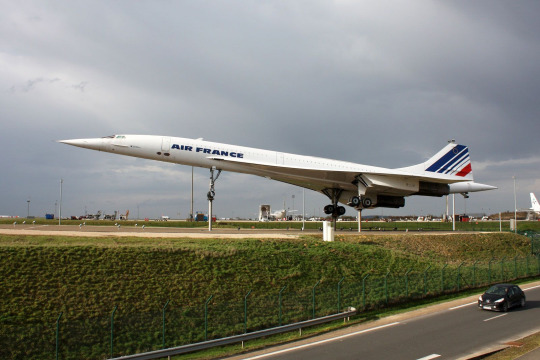
(concorde pictured above)
it was introduced into service in 1976, had seating for up to 128 passengers, and was built for speed instead of comfort (a no longer popular philosophy lol). it could in fact fly at twice the speed of sound at supercruise, and could complete transatlantic flights in around 3 hours over the average upwards of 7 hours of other planes then and now (interesting? side note, the fastest subsonic transatlantic flight took 4 hours and 56 minutes and was performed with a boeing-747 in 2020)
in total, only four airlines ever operated the concorde. two of them ceased operations in 1980, mostly because the operating costs were high as fuck because of how much fuel the concorde consumed. the other two airlines (air france & british airways) operated the concorde longterm. tickets were sold at a premium (a roundtrip costing at least $10,000 in 1980s dollars), but passengers were treated to the best service & food, and had exclusive lounges at airports.
as the concorde was built for speed over comfort, they were very small planes. very squished. and they were loud the whole flight, but apparently most people were understandably impressed by their (likely) first supersonic flight and didn't care. they gave signed certificates after you flew on a concorde flight. people would gather to watch concordes take off if they couldn't fly themselves. oh and they had unlimited champagne 🥂

look how small it is i would bump into literally everyone if i wore more than a single layer of clothing
concorde ceased operations in 2003, a few years after its only fatal crash. nowadays they're mostly in aviation museums. supersonic flight didn't really prove to be as popular as the concorde manufacturers thought, and since then the philosophy has shifted to comfort over speed.
but i think there's some us airliner vowing to bring back supersonic flight within the decade, though there are problems with that too, mainly noise & pollution. anyway fjfjjfj thanks for inviting me to ramble
2 notes
·
View notes
Text
Beyond the Clouds: A Journey Through the Evolution of Air Travel
Since the historic flight by the Wright brothers in 1903, air travel has undergone a remarkable evolution, transforming from a novel experiment to a vital component of global transportation. Groundbreaking innovations, technological advancements, and the relentless pursuit of speed and efficiency have marked this journey. Let's embark on a journey through time to explore the fascinating evolution of air travel, from the humble beginnings of powered flight to the era of supersonic jets.
The Pioneering Era:
In December 1903, Orville and Wilbur Wright achieved what many thought impossible: powered flight. Their revolutionary aircraft, the Wright Flyer, made a 12-second flight, covering a distance of 120 feet at Kitty Hawk, North Carolina. This historic achievement ignited the imagination of inventors and engineers worldwide, sparking the dawn of aviation.
The Golden Age of Aviation:
The 1920s and 1930s witnessed the rapid development of commercial aviation, heralding the golden age of air travel. Airlines such as Pan American Airways and Imperial Airways pioneered long-distance routes, connecting continents and shrinking the world. Aircraft like the Boeing 247 and the Douglas DC-3 offered unprecedented levels of comfort and reliability, making air travel accessible to a broader audience.
The Jet Age Takes Flight:
The introduction of jet propulsion in the late 1940s revolutionized air travel, propelling aircraft to new heights of speed and efficiency. The iconic Boeing 707, introduced in 1958, ushered in the jet age and transformed long-distance travel. Jet-powered aircraft could fly faster, higher, and farther than their piston-engine counterparts, shrinking travel times and opening up new possibilities for exploration and commerce.
The Rise of Commercial Aviation:
The latter half of the 20th century saw a surge in commercial aviation, fueled by technological advancements and growing demand. Aircraft manufacturers such as Boeing, Airbus, and McDonnell Douglas competed fiercely to produce more efficient, cost-effective, and comfortable aircraft. Innovations like computerized flight systems, composite materials, and advanced aerodynamics have made air travel safer and more reliable than ever before.
Supersonic Dreams:
In the 1960s, the dream of supersonic passenger travel became a reality with the introduction of the Concorde. This marvel of engineering could cruise at speeds exceeding Mach 2, cutting transatlantic travel times in half. Despite its technological prowess and unparalleled luxury, the Concorde faced challenges, including high operating costs, noise regulations, and limited routes. Ultimately, the Concorde's commercial viability waned, and the fleet was retired in 2003, marking the end of an era of supersonic travel.
The Future of Air Travel:
Today, the aviation industry stands on the brink of another evolutionary leap. Advances in electric propulsion, autonomous flight, and sustainable fuels promise to reshape the way we think about air travel. Electric aircraft are poised to revolutionize short-haul flights, offering quieter, cleaner, and more efficient transportation options for urban air mobility and regional travel. Meanwhile, research into hypersonic flight could unlock the potential for even faster and more economical long-distance travel.
Challenges and Opportunities:
As air travel continues to evolve, it faces a myriad of challenges, including environmental concerns, infrastructure constraints, and regulatory hurdles. The industry must address growing emissions, noise pollution, and congestion while ensuring safety, accessibility, and affordability for passengers worldwide. Innovations in sustainable aviation fuels, next-generation air traffic management systems, and advanced materials will be crucial in meeting these challenges and unlocking the full potential of air travel in the 21st century.
From the daring experiments of the Wright brothers to the promise of hypersonic flight, the evolution of air travel is a testament to human ingenuity, perseverance, and ambition. As we look to the future, the possibilities are boundless. Whether it's crossing continents in hours or exploring new frontiers beyond Earth's atmosphere, one thing is sure: the sky is no longer the limit.
0 notes